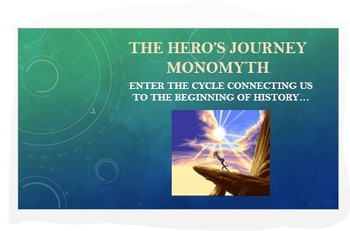Detailed Hero's Journey PPT: Jung & Campbell Monomyth Cycle w/Analysis!
- PPTX
Description
Highly visual, interactive 24-slide presentation w/custom transitions and animations, relevant graphics and hyperlink in final slide to brief youtube video w/modern-day examples on the monomyth archetype. Everything is done for you: easily modify as needed to provide relevant, contemporary cultural examples, as you wish!
In this engaging PPT, you're purchasing:
a.) An invitation at the start for students to identify prior knowledge of what makes a hero figure, including peer share time.
b.) Learning Targets/Goals ~ clarified FOR you!
c.) A brief introduction to both Carl Jung and Joseph Campbell, including definitions for archetype, the collective unconscious, and monomyth.
d.) Helpful, instructive overview slide of the entire hero's journey monomyth, including the 17 steps or "stages," outlined as Separation, Initiation, and Return.
e.) Brief slide example for the Disney film "Finding Nemo" ~ how it "fits" the hero monomyth archetype.
f.) Slides defining and providing modern examples for each of the 17 stages or steps, including the following:
-I Am Legend
-Disney's Hercules
-Disney's The Lion King
-Disney's Tangled
-Jason and the Argonauts (including visuals from the 2000 film)
-Batman Begins
-The Star Wars trilogy
-The Lord of the Rings trilogy
-The Matrix
-Coraline
-The Hunger Games
-The Neverending Story
-The Wizard of Oz
-Ironman
-The Harry Potter series
-Indiana Jones and The Raiders of the Lost Ark
-The film version of 300
g.) Hyperlinked connection to a short monomyth video in which several examples of contemporary hero's journey stories are shared for further connection.
h.) Finally, an invitation for higher-order thinking where students are assigned to seek a story/myth/character of their choosing and briefly analyze how, where, and why this hero "fits" the stages of the hero's journey, to share in the next class meeting.
This can be used in any ELA or Films course in which you wish to introduce and have students working with the hero archetype, particularly the Campbellian monomyth. When you wish to introduce the genre/archetype, this is a wonderful place to start. Everything here is done for you: you may wish to add in your own particular examples to revise those with which you're less familiar, but other than this, it's all done for you -- including learning targets/goals!
With this PowerPoint notes/activity, you are able to draw on students' abilities to work within the mid-higher levels of Bloom's Taxonomy (eg. moving beyond comprehension to application, analysis, and evaluation) AND expecting students to demonstrate their 21st Century Skills according to the Common Core Standards (eg. critical thinking/media literacy). This engaging item packs a lot into one printable, graphic, detailed slideshow for you!
Thanks for checking out my store, ENJOY, and I look forward to your feedback!





